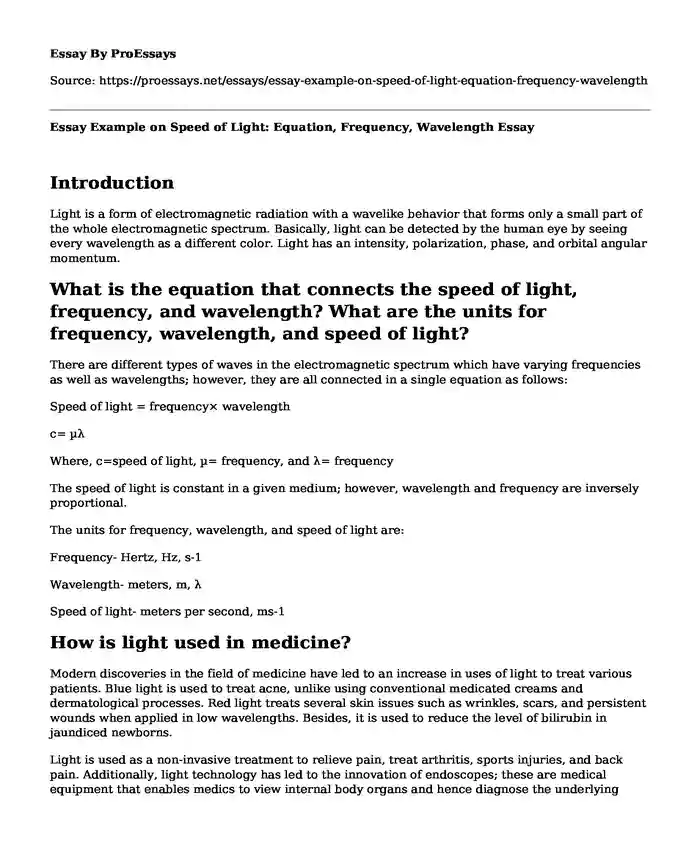Introduction
Light is a form of electromagnetic radiation with a wavelike behavior that forms only a small part of the whole electromagnetic spectrum. Basically, light can be detected by the human eye by seeing every wavelength as a different color. Light has an intensity, polarization, phase, and orbital angular momentum.
What is the equation that connects the speed of light, frequency, and wavelength? What are the units for frequency, wavelength, and speed of light?
There are different types of waves in the electromagnetic spectrum which have varying frequencies as well as wavelengths; however, they are all connected in a single equation as follows:
Speed of light = frequency× wavelength
c= µλ
Where, c=speed of light, µ= frequency, and λ= frequency
The speed of light is constant in a given medium; however, wavelength and frequency are inversely proportional.
The units for frequency, wavelength, and speed of light are:
Frequency- Hertz, Hz, s-1
Wavelength- meters, m, λ
Speed of light- meters per second, ms-1
How is light used in medicine?
Modern discoveries in the field of medicine have led to an increase in uses of light to treat various patients. Blue light is used to treat acne, unlike using conventional medicated creams and dermatological processes. Red light treats several skin issues such as wrinkles, scars, and persistent wounds when applied in low wavelengths. Besides, it is used to reduce the level of bilirubin in jaundiced newborns.
Light is used as a non-invasive treatment to relieve pain, treat arthritis, sports injuries, and back pain. Additionally, light technology has led to the innovation of endoscopes; these are medical equipment that enables medics to view internal body organs and hence diagnose the underlying issue(s). Ultra-violet light below 290nm is sometimes used to sterilize medical instruments instead of using chemicals. Finally, it is used to treat Seasonal Affective Disorder (SAD), which occurs particularly during fall and winter. The patient's workaround or stays near a light therapy box which has similar outdoor light that reduces the symptoms of SAP. Although light therapy is safe in treating various conditions, physicians should be cautious when using it as it may have adverse side effects to different patients, for instance, severe headaches, loss of sleep, skin cancer, among other problems.
Which question about light amazed you mostly? What is the answer?
The question that amazed me most is "what is the color of the sun?" The real color of the sun is white; however, sometimes, the sun appears to be yellow, orange, or even red. This is because the earth's atmosphere releases higher wavelength colors that are easily visible; therefore, these wavelengths are what we see. The blue and violet waves, which are usually shorter, strike air molecules in the upper side of the atmosphere and scatter, making the sun appear red. According to research, the sun emits all colors due to its thermal body, which causes illumination of sunlight; this is the reason why we are able to see various colors in the natural world. If the sun contained only one color, then everything in the natural world would appear to be that color. Moreover, the sun emits all frequencies of electromagnetic waves such as radio waves, microwaves, infrared waves, visible light, ultraviolet waves, and X-rays except waves of gamma rays.
Cite this page
Essay Example on Speed of Light: Equation, Frequency, Wavelength. (2023, Sep 10). Retrieved from https://proessays.net/essays/essay-example-on-speed-of-light-equation-frequency-wavelength
If you are the original author of this essay and no longer wish to have it published on the ProEssays website, please click below to request its removal:
- Geography Essay Example: An Overview of the Australia
- Was Moon Landing a Hoax or Did It Actually Occur? - Paper Example
- The Effect of Geography - Essay Sample
- Asteroids, Meteors: Impacts on Earth & ASTR 202 Life in The Uni - Essay Sample
- Paper Example on Unlocking Potential: How DFT Revolutionised Many-Body Quantum Mechanics
- Concentration & Dilution: Impacts on Collision of Molecules & Reaction Rates - Essay Sample
- Free Essay Example on Ethanol & Fuel: Advantages of Biofuel Additive for Gasoline







